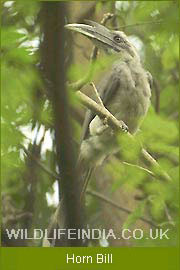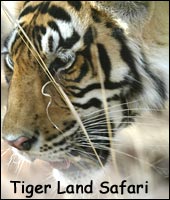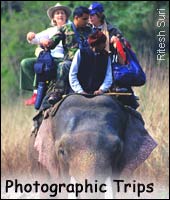HOME : National Parks India :
Manas National Park
MANAS NATIONAL PARK
| Location of Manas | : | Assam, North East India |
| Nearest Access to Manas | : | Guwahari (176-kms) |
| Coverage Area of Manas | : | 391-sq-kms |
| Climate of Manas | : | Winter Min. 11°C , Summer Max.37°C . |
| Major Wildlife Attraction in Manas | : | Great Hornbill, Tigers, Leopards |
| Best Time to Visit Manas | : | October to April. |
About Manas National Park
 Located in the foothills
of the Mighty Himalayas, Manas has been designated as World Heritage Site by
UNESCO. Manas has unique distinction of being home of some of the highly endangered
animals like Pigmy Hog, Golden Langur. Manas has a remarkable diversity of forest
vegetation within the confines of the park. It is flanked by the sub-Himalayan
mixed deciduous forests and Assam valley evergreen forests to the north and
a combination of rich bhabar Sal, eastern wet alluvial grassland around the
Benki and Hekua rivers and alluvial Savannah woodlands to the south. Manas also
has a unique distinction of being a treasure house of plants and trees around
550 species, which include some rare varieties of wild orchid.
Located in the foothills
of the Mighty Himalayas, Manas has been designated as World Heritage Site by
UNESCO. Manas has unique distinction of being home of some of the highly endangered
animals like Pigmy Hog, Golden Langur. Manas has a remarkable diversity of forest
vegetation within the confines of the park. It is flanked by the sub-Himalayan
mixed deciduous forests and Assam valley evergreen forests to the north and
a combination of rich bhabar Sal, eastern wet alluvial grassland around the
Benki and Hekua rivers and alluvial Savannah woodlands to the south. Manas also
has a unique distinction of being a treasure house of plants and trees around
550 species, which include some rare varieties of wild orchid.Manas has a relatively longer period of Monsoons resulting in creation of different types of terrain due to siltation from countless seasonal rivers and nalahs. The upper foothills are bhabar tracts and the lower one the terai tract. The terai tract contains plenty of ground water as a result the tall grasslands support an extensive number of wild animals and harbors some rare and endemic species. Manas is also home to 60 mammals, of which 41 have been listed in the IUCN’s Indian Wildlife Protection Act of 1972. They include Tiger, Leopard, Clouded Leopard and some of the smaller cats like Marbled, Leopard, Golden and Fishing. Other mammals are Great Indian Rhinos, Indian Elephant, Indian Wild Buffalo, Red Panda and Capped Langur. The most endangered animals in the park are Golden Langur, Pygmy Hog and Hispid hare.
With its varied habitats, Manas has countless species of birds. Some of the bird species of interest are Assamese Myna, Indian Lorikeet, Rufous-bellied Niltava, Rubycheek, Crossbill, Malkoha, kalij Pheasant, Orange-bellied Blue Magpie, Blue-headed Flycatcher, Great Indian Hornbill, Indian Hobby and Blyth’s Baza. Large flocks of migratory birds like Large Cormorants, Grey Heron, Yellow Bittern, Lesser Whistling Teal and Comb Duck make winter home in Manas river and its tributaries.
How to reach Manas National Park
Air : Manas Park is 176-kms from Guwahati.
Rail : The nearest railhead is situated at Barpeta road.
Road : Buses regularly ply from Guwahati to Barpeta Road in 4½ hrs.
SUGGESTED TOURS
» Jewels of East
SUGGESTED RESORTS



